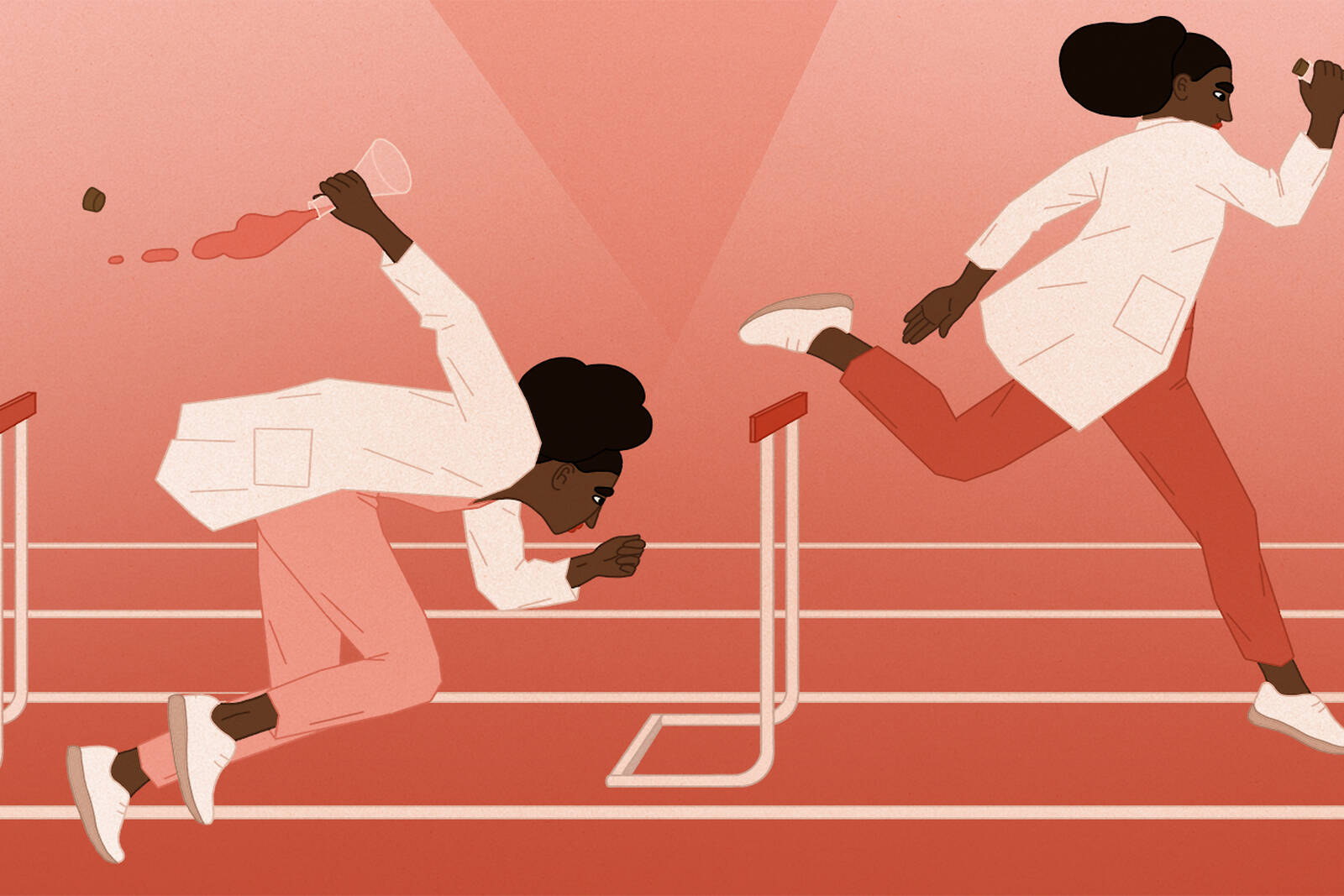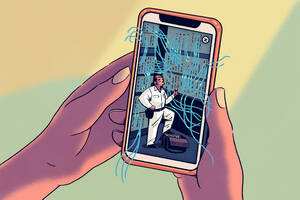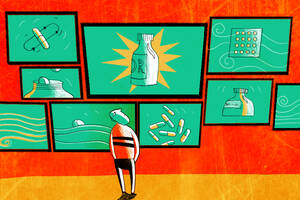These are inspiring examples, to be sure—but Dashun Wang didn’t think they told the whole story. Why did these individuals ultimately succeed, when so many others never manage to get past their failing phase?
“If we understand that process, could we anticipate whether you will become a winner, even when you are still a loser?” asks Wang, an associate professor of management and organizations at the Kellogg School, who directs the Center for Science of Science and Innovation (CSSI).
In a new paper published in the 150th anniversary issue of Nature, Wang and colleagues developed a mathematical model to pinpoint what separates those who succeed from those who merely try, try again. Along with PhD student Yian Yin and postdoctoral researcher Yang Wang at CSSI, and James A. Evans of the University of Chicago, Wang found that success comes down to learning from one’s prior mistakes—for instance, continuing to improve the parts of an invention that aren’t working rather than scrapping them, or recognizing which sections of a denied application to keep and which to rewrite.
But it’s not simply that those who learn more as they go have better odds of victory. Rather, there’s a critical tipping point. If your ability to build on your earlier attempts is above a certain threshold, you’ll likely succeed in the end. But if it’s even a hair below that threshold, you may be doomed to keep churning out failure after failure forever.
“People on those two sides of the threshold, they could be exactly the same kind of people,” says Wang, “but they will have two very different outcomes.”
Using this insight, the researchers are able to successfully predict an individual’s long-term success with just a small amount of information about that person’s initial attempts.
Measuring Success in Three Different Domains
A growing body of research supports the idea that failure can make you better off in the long run. Indeed, in another recent study, Wang himself found that an early career setback often set up scientists for later success.
However, as the stories of Ford, Edison, and Rowling plainly demonstrate, the road to success typically involves more than a single setback. “You don’t just fail once,” Wang says. “You fail over and over.” And while that litany of failures may make the Edisons of the world better off, it seems to thwart many other people.
To understand why, Wang and his colleagues needed a lot of information about the process of falling, getting back up, and trying again.
They turned to three massive data sets, each containing information about very distinct types of failure and success: 776,721 grant applications submitted to the National Institutes of Health (NIH) between 1985 and 2015; the National Venture Capital Association’s database of all 58,111 startups to receive venture-capital funding from 1970 to 2016; and the Global Terrorism Database, which includes 170,350 attacks between 1970 and 2016.
These sources allowed the researchers to track groups and individuals as they made repeated attempts over time to achieve a goal: obtain grant funding, lead their company to get acquired at high values or achieve an IPO, or, in the case of terrorist organizations, execute an attack with at least one fatality—a grim measure of success, to be sure.
The three domains “can’t be more different,” Wang says, “but as different as they seem, what’s interesting is that they all turn out to show very similar, predictable patterns.”
What Makes You Successful: Luck or Learning?
With data in hand, the team began thinking about success and failure at the simplest level. Success, they theorized, must be the result of one of two basic phenomena: luck or learning. People who become successful in a given area are either improving steadily over time, or they are the beneficiaries of chance. So the researchers tested both theories.
If wins are primarily the result of chance, the team figured, all attempts are equally likely to succeed or fail—just like a coin toss, where what happened before doesn’t much influence what happens next. That means the typical person’s hundredth attempt won’t be any more successful than their first, since individuals are not systematically improving.
So the researchers looked at the first attempt and the penultimate attempt (the one right before a win) for each aspiring scientist, entrepreneur, and terrorist in their dataset. To measure improvement (or lack thereof) over time, the researchers looked at changes in how the scientists’ grant applications were rated, the amount of venture funding the startups received, and the number of individuals wounded in terrorists’ attacks.
Analysis revealed that the chance theory doesn’t hold up. In all three datasets, an individual’s second-to-last attempt did tend have a higher probability of success than their very first effort.
Yet people weren’t learning in the way the researchers had expected. The classic idea of the learning curve says that the more you do something, the higher your proficiency gets. So if everyone in the dataset was reliably learning from their prior failures, their odds of success should increase dramatically with each new attempt, leading to short-lived failure streaks before success.
But the data revealed much longer streaks than the researchers anticipated.
“Although your performance improves over time, you still fail more than we would expect you to,” Wang explains. “That suggests that you are stuck somewhere—that you are trying but not making progress.”
In other words, neither of the two theories could account for the dynamics underlying repeated failures. So the researchers decided to build a model that accounted for that.
A Surefire Predictor of Success
This model assumes that every attempt has several components—like the introduction and budget sections of a grant proposal, for instance, or the location and tactics used in a terrorist attack. Importantly, even if an attempt fails overall, some of its components may still have been good. When mounting a new attempt, an individual has to choose, for each component, whether to go back to the drawing board or to improve upon a version from a prior (failed) attempt.
A person evaluates the components of their past tries based on feedback from others (for the people in Wang’s analysis, feedback might come from the NIH, venture capitalists, or higher-ups in a terrorist organization).
But the model acknowledges that some people learn from their failed attempts more than others, with those who “learn more” incorporating more components of their failed attempts into their later attempts.
At one extreme, the very worst learners incorporate zero information from their previous tries, starting from scratch on every component every time. At the other extreme are perfect learners, who consider all of their past failures with each fresh attempt. Most people are somewhere between these two extremes.
While perfect learners will likely achieve success quickly, the model predicts, the worst learners have a low chance of success—since they never learn anything, they simply “thrash around for new versions,” Wang says, wasting valuable time going back to the drawing board again and again.
The researchers tested this model with their data, using average time between attempts as a proxy for an individual’s learning ability (since better learners will start from scratch on fewer components, allowing them to produce new iterations quickly).
What they found was a surprising relationship between learning and eventual victory. It’s not the case that each additional unit of learning boosted one’s odds of success equally. Rather, there’s a singular learning threshold that separates eventual successes from the rest.
Wang compares this threshold to the transition between water and ice. “Imagine I go from -5 to -4 degrees Celsius,” he explains. “Nothing happens. The ice stays as ice.” But the moment the temperature hits a particular point, it begins to melt.
Similarly, if someone’s learning ability is below the threshold, it’s as if they were learning nothing at all. They may improve slightly over time, Wang says, but they will never retain enough good components to produce a full-throated success.
But those beyond the threshold should retain enough lessons to all but guarantee success. They produce new iterations faster and faster over time, until they eventually have a successful one.
In practical terms, this means you don’t need to learn from all of your past experiences in order to eventually succeed, Wang explains. But there is a minimum number of failures you need to learn. While that is not easily quantifiable in every case, the researchers did pinpoint the threshold for NIH grants at around 3.
How You Fail Determines Whether You’ll Succeed
The research dismisses the common idea that success is a product of sheer chance and also sheds new light on what it really takes for an amateur to become a winner.
To simply “try, try again,” for example, is not enough. The data show that individuals below the learning threshold made just as many attempts as the those above, and likely worked even harder, since they insisted on making changes to their perfectly good earlier attempts. But this hard work was fruitless, since it wasn’t incorporating past tries.
For Wang, the lesson is clear: people should place a high premium on feedback, as well as on lessons they learn through failure. “These are two very valuable assets you now have to launch another attempt,” he says. But the study reveals that they’re only valuable if you can incorporate them into new attempts, bearing out the Silicon Valley mantra that “failing better” is key to success.
The study also dispels some of the mystery behind who succeeds and who doesn’t. The researchers found that the learning ability of a given entrepreneur, scientist, or terrorist can be discerned by simply measuring how much time passes between their first few attempts. As a result, their model was able to accurately predict which entrepreneurs, scientists, and terrorists would eventually succeed long before any outward signs of success appear.
“Thomas Edison said, ‘people give up because they don’t know how close they are to success,’” Wang explains. “Well, what the paper contributes is, now we know. Because if we have data about how you fail, we have a better idea of where you’re headed.”




